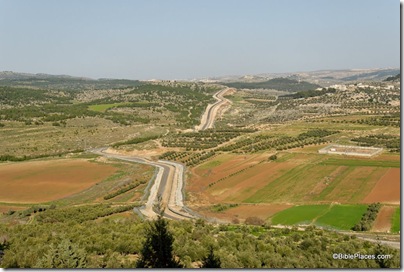According to the book of 1 Samuel, David found an ideal hideout at Adullam where he gathered hundreds of men into a small militia. In his earlier days, David had served King Saul well, but the king’s growing jealousy of his popular warrior forced David to flee. For reasons that don’t seem to make sense, David thought he could find safety in the Philistine city of Gath. When his identity was discovered, his feigned madness allowed him to escape once more. Desiring safety from both the Israelite forces as well as the Philistine garrison, David found refuge at the ideal location of Adullam (1 Sam 22).

Aerial view to the east.
Adullam is the tree-covered hill in the center.
Adullam has been identified as Tell esh-Sheikh Madhkur, and its situation is ideal for one seeking to avoid the Israelites and the Philistines because it was effectively located in “no man’s land.” The Israelites controlled the hill country to the east, and the Philistines were in possession of the coastal plain to the west. That left the low rolling foothills known in the Bible as the Shephelah as the “middle ground.” It was in this region that the Israelite Samson had defeated the Philistines, and it was here where David’s slingstone sent the Philistines running. During the period of the late judges and early monarchy, the Shephelah was contested ground that neither party could consistently control.
Adullam is situated on the eastern edge of the Shephelah, well out of range of the Philistines and apparently in territory that the Israelites were reluctant to travel. This reality is borne out by the story in the next chapter, in which the Philistines are attacking Keilah (Khirbet Qila), a city about three miles (five km) south of Adullam. Saul was apparently unwilling to go to the city’s defense, and it was only his motivation to capture David that changed his mind (1 Sam 23). That Adullam was apparently safe from either side is suggested in the comment that David was joined by men in debt and distress.
The situation of Adullam today is remarkably similar to ancient political realities, though the sides have switched. Israelis hold the territory once controlled by the Philistines, whereas the Arab Palestinians live in the hill country of Judah. The Shephelah is mostly populated by Israeli cities and villages, but parts of the eastern Shephelah are on the other side of the “green line.” Adullam today sits immediately next to the large border fence that Israel has constructed to prevent unauthorized access by Palestinians. A few years before that fence was erected, a friend and his wife were hiking in the area and decided to camp the night on the hill of Adullam. My friend was crossing a portion of the site that evening when he was suddenly tackled in the darkness. An enforcement team from the Israel Antiquities Authority was monitoring the site because of recent illegal excavation activity. The site was attractive to thieves because of its easy access to and from the Palestinian territories.
 View east from Adullam showing the border fence
View east from Adullam showing the border fence
Recently Adullam has been in the news because of oil exploration in the area. According to a citizen group fighting the project, the American company IDT has been given a license without public hearings of environmental assessments. The commercial activity was only discovered when a resident of nearby Moshav Aderet happened upon it while out for a walk. In some ways it is not surprising that the government would grant such permission and that the activity would be discovered by accident, given Adullam’s location. Its out-of-the-way location is just as attractive to oil drillers today as it was to David in antiquity.

